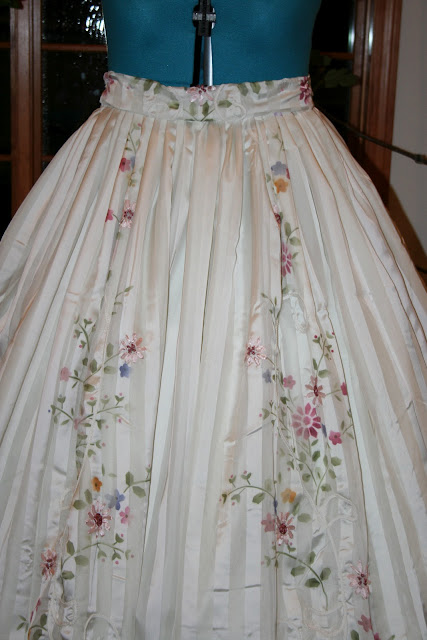 The weekend started with a Steerage Dance. I wore a vintage blouse with a long black skirt, draped jacket, and straw hat. The skirt had a shirred belt with a matching swag.
The weekend started with a Steerage Dance. I wore a vintage blouse with a long black skirt, draped jacket, and straw hat. The skirt had a shirred belt with a matching swag.Steve wore a frock coat over a period shirt with garters on his sleeves, a satin vest and bowler.
We met a wonderful couple from Texas and danced the evening away.
 |
| At 71, he is as much of a hit as he was in the 60's! |
For the Steerage Dance, Ian Whitcomb, the foremost ukelele, ragtime, and tin pan alley historian and musician entrained us with anecdotes and period music.
He played an incredible array of instruments and he was just as funny and just as versatile as hewas when he sang "You Turn Me On" in 1965.
He and his lovely wife Regina, who joined him for a Sunday afternoon concert, was a delightful addition to the weekend.
 |
| Ian Whitcomb and his fellow musicians entertained us with wonderful music to dance to |
 |
| In addition to fancy sandwiches and meat pasties, there were cheese spreads, fruits, savories, breads, and pastries. |
 |
| Steve wore tails and his bowler. |
The ambiance in the room harkened back to a much more elegant period. Voices were soft, crystal and silver gleamed, and everyone was smiling, happy, and relaxed.
It was amazing how many men attended, and all of them dressed and accessorized in keeping with the period.
One of the women regaled us with stories of how her husband usually spends Saturday afternoons: dressed in his favorite team's sweats or muscle shirt, beer in hand, shouting at the coaches and referees on TV. She was amazed at how he had been totally transformed from a sports fanatic into a dapper, tuxedoed, aristocrat wearing gloves and sporting a top hat.
Wandering from table to table was like paging through a full color edition of Godey's Ladies Book. (Yes, I know, Godey's ceased publication in 1898, 14 years before this event, but you get the point.)
Many of the women had authentic period hats, purses, and jewelry that they had taken from storage for the day. We shared notes about sources, seamstresses, and sewing patterns as we sipped a variety of herbal teas.
 |
| Some of us were risque, allowing our ankles to show. But above all, we made an elegant showing |
 |
My dress started out as a long lace skirt that I added pearl spaghetti straps to.
The overlay, which I made from a bargain aisle fabric remnant, is cinched at the waist with a belt.
The earrings were handcrafted by Diane Reilly and are an exact replica of those worn by The Mrs. Aster in her portrait. She also crafted he triple strand pearl necklace. The unusual gray-green pearls pick up on the green in the overlay and they are blended with with pale straw and ivory pearls and gold filigree beads.
The purse is a Mary Frances mini bag that I acquired several years ago. I splurged on three different purses and had not had many occasion to use them until we began period dancing. This was the first time I'd ever carried this clutch. Since this event, I've worn this outfit several times and the purse always attracts compliments.
The touring hat and boots are from Recollections.biz.
Steve enjoyed dressing up as much as I did. He chose the cane from the selection at Gentleman's Emporium. His tails, vest, bow-tie and bowler are from Giblee's in Danvers, MA. Giblee's offers tails and accessories that have been used as rentals for sale at heavily discounted prices.
 |
| The detail in the earrings and necklace are exquisite. The Mary Frances mini bag was the perfect finishing touch. |
 |
| Dressed in their finest for tea.... I loved the amazing variety of dresses and hats and could |
 The balconies, reminiscent of the outside decks, were set with tables where guests enjoyed cocktails and later, coffee and dessert.
The balconies, reminiscent of the outside decks, were set with tables where guests enjoyed cocktails and later, coffee and dessert. Ian Whitcomb joined the period orchestra and we danced to a wonderful blend of rag time and other period music. The one step, waltz, tango, and fox trot were featured along with some of the line dances and progression dances of the time.
Ian Whitcomb joined the period orchestra and we danced to a wonderful blend of rag time and other period music. The one step, waltz, tango, and fox trot were featured along with some of the line dances and progression dances of the time. |
| Waltzing to the same music that was played on the fateful voyage. The committee researched the music and offered dance workshops so the evening would be as authentic as possible. |
The weekend ended with a promenade at the Peabody Essex Museum followed by a concert featuring Ian Whitcomb. Steve and I wore the same outfits we'd worn for tea the day before. Museum guests were delighted when our group descended on the exhibits in our period regalia. One woman asked if we were a part of a living exhibit.
We had a chance to walk through town, shop, and have a light lunch before the concert and we were stopped several times by other tourists and shoppers who wanted to snap photographs of us It was a wonderful, memorable weekend that we hope it is repeated in the future.
















